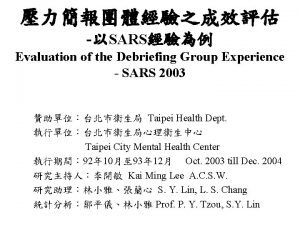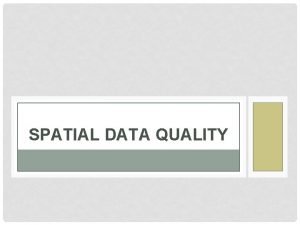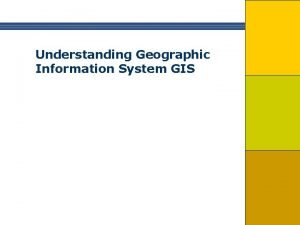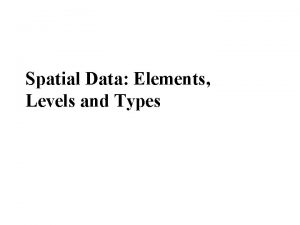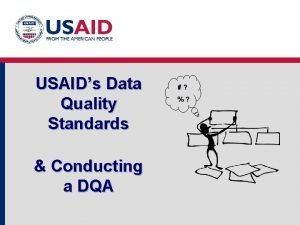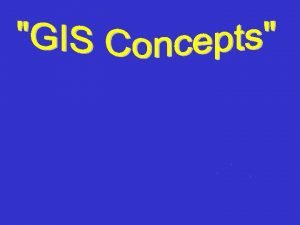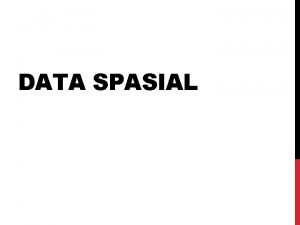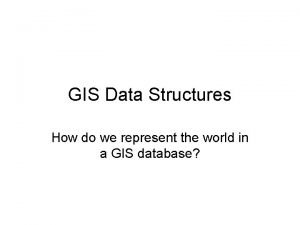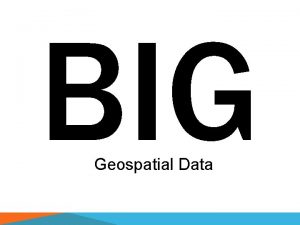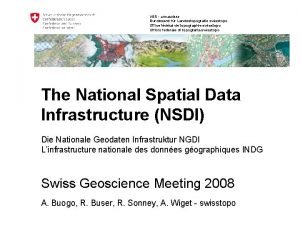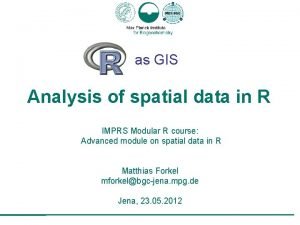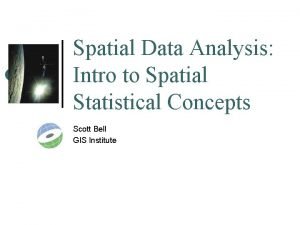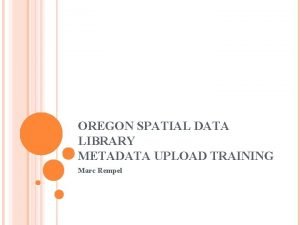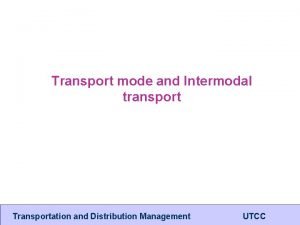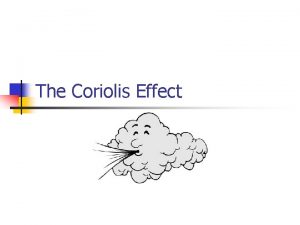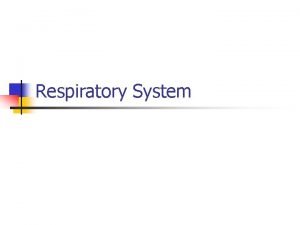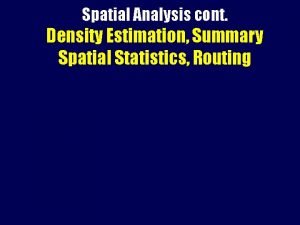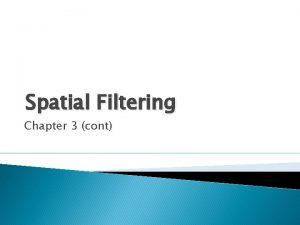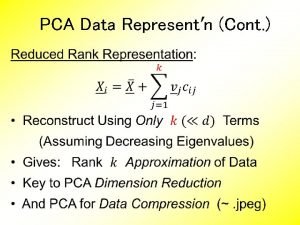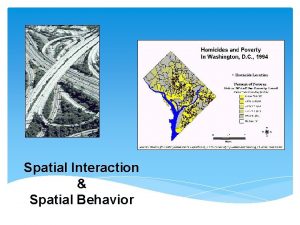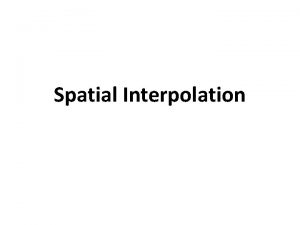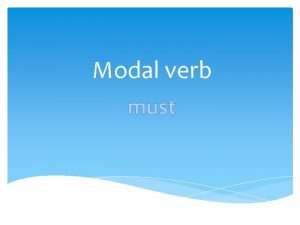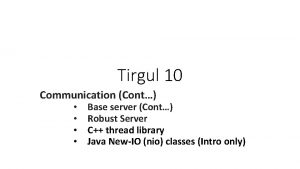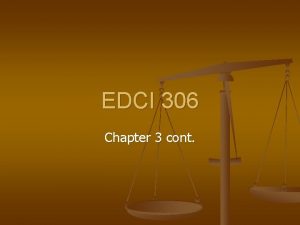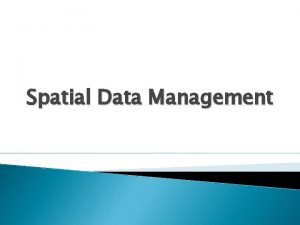SPATIAL DATA QUALITY CONT Data quality standards must





























- Slides: 29

SPATIAL DATA QUALITY

CONT. • Data quality standards must serve the needs of the users according to their budget, technical capabilities, and rate of production.

COMPONENTS OF SPATIAL DATA QUALITY • There are 9 components that affect the quality of the data. • These components have been grouped into 3 categories are: • 1. Micro Level Components • 2. Macro Level Components • 3. Usage Components.

Micro Level Components

MICRO LEVEL COMPONENTS • Micro level components are data quality factors that pertain to the individual data elements. • Positional Accuracy • Attribute Accuracy • Logical Consistency • Resolution

MICRO LEVEL COMPONENTS Positional Accuracy: • is the expected deviation in the geographic location of an object in the data set from its true position • There are two components to positional accuracy are; • Bias • Precision • The bias refers to the systematic discrepancies between the represented and true position. Ideally the bias should be zero. • Bias is commonly measured by the mean / Average positional error of the sample points.

MICRO LEVEL COMPONENTS Positional Accuracy: • Precision refers to the dispersion of the positional errors of the data elements. • Precision is commonly estimated by calculating the standard deviation of the selected test points. • A low standard deviation indicates that the data points tend to be very close to the mean • Higher the precision better the data for use. • Commonly the accuracy is measured in RMS error.


MICRO LEVEL COMPONENTS • Attribute Accuracy: may be discrete or continuous variables. • A discrete variable can take on only a finite number of values e. g. Land use class, Vegetation type, or administrative boundaries. • Ratings is also discrete variables. They are ordered in categories where the order indicates the hierarchy of the attribute. • Low (1) to High (4)


MICRO LEVEL COMPONENTS Attribute Accuracy: • Continuous variables can take on any number of value. • Temperature • Average property value are continuous • Hence, the variable can take on any value so intermediate values are valid.

MICRO LEVEL COMPONENTS • Logical Consistency: refers to how well logical relations among data elements are maintained. • For Example • There must be a consistency between forest stand boundaries and to the center of adjacent roads • Political and administrative boundaries defined by physical features should precisely overlay those features. • The edge of the property that borders a lake should coincide with the lake boundary.

MICRO LEVEL COMPONENTS

MICRO LEVEL COMPONENTS • Logical Consistency: is best addressed before data are entered in GIS data base. Hence, there is no standard measure of logical consistency. • � The map preparation stage includes to check, redraft (correct errors), and reconcile discrepancies , known as conflation process.

MICRO LEVEL COMPONENTS • Resolution: of a data set is the smallest understandable unit or the smallest unit represented. • In aerial camera or in satellite images the smallest units that can be understood , called spatial resolution. • Area of the earth’s surface represented in a single digital image value is known as spatial resolution. • For thematic maps such as soil maps, land use maps, the resolution is the size of the smallest object that is represented , called minimum mapping unit.

MICRO LEVEL COMPONENTS • Resolution: But geographic data stored in GIS data base can be represented at any scale. • Labeling and other map details can be added according to the required output scale. • Data do not have a specific scale, they are produced according to the resolution and accuracy required to produce intended results.

Macro Level Components

MACRO LEVEL COMPONENTS • Macro level components of data quality pertain to the data set as a whole. • Such as; • Completeness • Time • Lineage

MACRO LEVEL COMPONENTS • Completeness: is further sub divided into three parts are; • Completeness of coverage • Completeness of classification • Completeness of verification • The completeness of coverage is the proportion of data available for area of interest. • A data set may not provide complete aerial view or attribute data may not be available some of the data set.

MACRO LEVEL COMPONENTS • Completeness of classification is an assessment of how well the cohesion classification is able to represent the data.

MACRO LEVEL COMPONENTS Forest (Conifer and deciduous classification) Urban (Residential , Commercial, Industry) Water (Salinity classification) Agriculture • Grains • Truck crops • Carrots • Tomatoes • Other Live stock • Cattle • Hog • Sheep

MACRO LEVEL COMPONENT • Completeness of Verification refers to field measurements or other independence sources of information that were used to develop the data. For example • A geologist can verify the quality of the data by applying solid line to a map rocks types as he has direct field evidence.

MACRO LEVEL COMPONENT • Time: is very important factor when using different types of geographic data such as demographic, Land cover. • The time aspect of data quality is most commonly reported as the date of the source material , such as the date of aerial photography. • Topographic maps include updated information. • Forest inventory maps may be updated on a 5 to 10 years. • Crop condition changes rapidly , hence updated on a weekly basis. • Flood prone areas map are updated on daily basis.

MACRO LEVEL COMPONENT • Lineage: Processing steps to produce a data set is called lineage. • Transaction records • field notes • air photos and other maps. • Each data source and processing method introduces a level of error into the information that is ultimately produced.

Usage Components

USAGE COMPONENTS • • Accessibility: refers to the ease of obtaining data. Government held data Privately held data Direct and indirect cost of the data

SOURCES OF ERROR • Data collection • Data input • Error in field data collection • Error in base map • Error in the analysis of remote sensing data • Digitization error by operator or equipment

SOURCES OF ERROR • Data storage • Data management • Insufficient numerical precision • Insufficient spatial precision • Inappropriate class intervals • slivers

SOURCES OF ERROR • Data out put • Scaling inaccuracies • Error caused by inaccurate of the output devices • Use of result • Information may be incorrectly understand • Information may be inappropriately used
 Spatial data vs non spatial data
Spatial data vs non spatial data Cont or cont'd
Cont or cont'd Cont or cont'd
Cont or cont'd Elements of spatial data quality
Elements of spatial data quality Spatial data and attribute data
Spatial data and attribute data Spatial data and attribute data
Spatial data and attribute data International association for information and data quality
International association for information and data quality Dqa standards
Dqa standards He must become greater i must become less
He must become greater i must become less Customer defined service standards
Customer defined service standards Spatial data mining applications
Spatial data mining applications Spatial data acquisition
Spatial data acquisition Gis definition
Gis definition Gis
Gis Big spatial data
Big spatial data Data input techniques in autocad
Data input techniques in autocad Spatial big data platform
Spatial big data platform Gis data structure
Gis data structure Spatial data transformation
Spatial data transformation Big data spatial
Big data spatial Swiss vbs
Swiss vbs National spatial data infrastructure
National spatial data infrastructure Applied spatial data analysis with r
Applied spatial data analysis with r What is spatial data?
What is spatial data? Oregon geospatial data library
Oregon geospatial data library Spatial data infrastructure components
Spatial data infrastructure components Intermodal equipment logistics
Intermodal equipment logistics Objective of un
Objective of un Cont’n air
Cont’n air Cont'n air
Cont'n air

